How To Choose The Right Types of Brooms: Uses, Bristles & Benefits
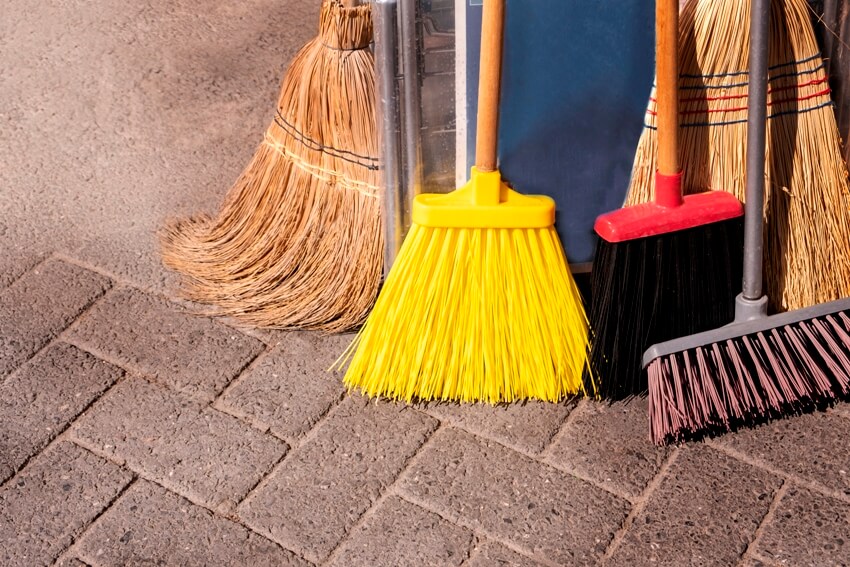
We are sure that you will agree that nothing beats the efficiency and cost-effectiveness of the right types of brooms, no matter how expensive a vacuum cleaner you purchase and use. When trying to clean up the edges and remove the dust and debris from those hard-to-reach corners of your space, brooms come in extremely handy.
If you are considering purchasing a broom for your cleaning needs or are already a regular user of brooms, the odds are you will choose one without much deliberation. Truly, the type you choose does matter. Choosing the appropriate one can make your routine chores much easier. Discover the numerous types of brooms, including their uses, benefits, sizes, bristle materials, cleaning tips, and the best broom choice for hardwood floors & pet hair.
Broom Selection Guide
| Broom Type | Best For | Surface | Description |
|---|---|---|---|
| Angle Broom | Indoor | Hardwood/Tile | Good for corners & edges |
| Microfiber Broom | Indoor | Hardwood/Tile | Excellent for fine dust & hair |
| Carpet Broom | Indoor | Carpet | Designed to agitate carpet fibers |
| Electric Broom | Indoor | Carpet | For quick cleanups on carpet |
| Corn Broom | Indoor | All-Purpose | Traditional, durable, good for many surfaces |
| Push Broom | Indoor | All-Purpose | Efficient for large indoor areas |
| Heavy-Duty Push Broom | Outdoor | Concrete/Asphalt | Sturdy for rough outdoor surfaces |
| Outdoor Angle Broom | Outdoor | Deck/Patio | Weather-resistant & great for outdoor dirt |
| Rake | Outdoor | Lawn/Garden | For leaves & light garden dirt |
| Garden Broom | Outdoor | Lawn/Garden | Stiff bristles for heavier outdoor cleaning |
Use our broom selection guide to guide find the best model for your use:
Broom Selection Guide
There’s a broom for all the different clean-up jobs you’ll have around the home. Let’s break down the ins and outs of the popular types to make choosing easier.
Standard Broom
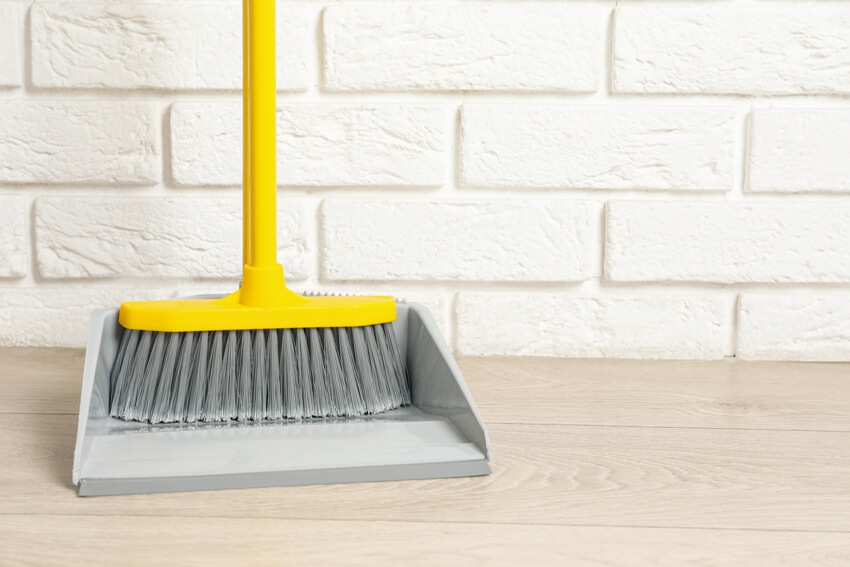
Standard brooms are the most typical style. These are the ones you normally purchase without much thought. Standard types are ideal for small indoor spaces and are effective for easily picking up debris and dust.
Furthermore, standard types come in a multitude of bristle types to support all sanitation and cleaning operations. For sensible reasons, the corn-bristle type, on the other hand, is the most commonly used bristle material.
It is quite incredibly robust but not so rigid that it will not break over time. The straight fibers of standard corn brooms can capture even the littlest amounts of debris and dirt and swiftly sweep it out from underneath furniture or around appliances.
In addition, standard brooms are reasonably priced and widely available, which makes them an ideal choice for the majority of households. This is a general-purpose broom that may be used on practically any surface. It has a bigger coverage area and is recognized to lift larger items off the ground.
Push Broom
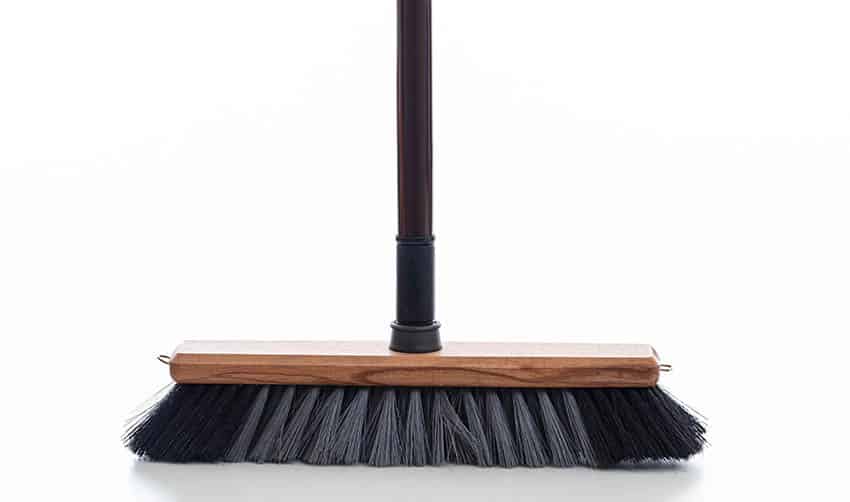
Push brooms have extremely firm bristles that make it extremely simple to clean vast areas in one go. Rather than needing to use a smaller broom repeatedly in a single area, a push broom allows you to clean a broad area rapidly.
Furthermore, push brooms are particularly effective at moving larger pieces of trash since small dust and dirt particles could accidentally sneak underneath the bristles and be left aside.
Plastic bristles are commonly used in these brooms because they are tough enough to withstand years of usage and being pushed around the floor all day.
Push brooms are commonly used in supermarkets and big department stores because they require fewer passes to clear the aisle or the cashier area and reduce the likelihood of a customer tripping and slipping on the items that are left on the floor.
Upright Broom And Dustpan

Upright brooms have their bristles arranged in the same direction as the handle rather than being pushed along the floor at an inclination. This makes them quite straightforward to use and get into small locations for most individuals.
They span a much less surface area than push brooms, but they accomplish the job equally well, albeit for a longer period. Lengthy handles can be challenging to use for youngsters or shorter adults, but the right upright broom makes sweeping the floor much simpler.
Most upright brooms include a dustpan. This combination will enable you to remove dirt, dust, and trash from the floor effortlessly and fast without needing to bend over and try to maintain the upright broom and dustpan at the perfect angles to operate. This type of broom is very much ideal for houses with senior citizens or tall household members.
Straw Broom

Straw brooms were one of the earliest types of brooms, and they were popular for their capacity to sweep a broad area. These brooms are used to clean floors and are often composed of a species of grass that grows one to five feet in height.
Moreover, a straw broom is best used outside or in small indoor locations such as the laundry area. Nevertheless, when it comes to sweeping up dust or small particles, these brooms fall short. Also, if you continuously use a straw broom, the bristles would be likely to fall apart.
Angle Broom
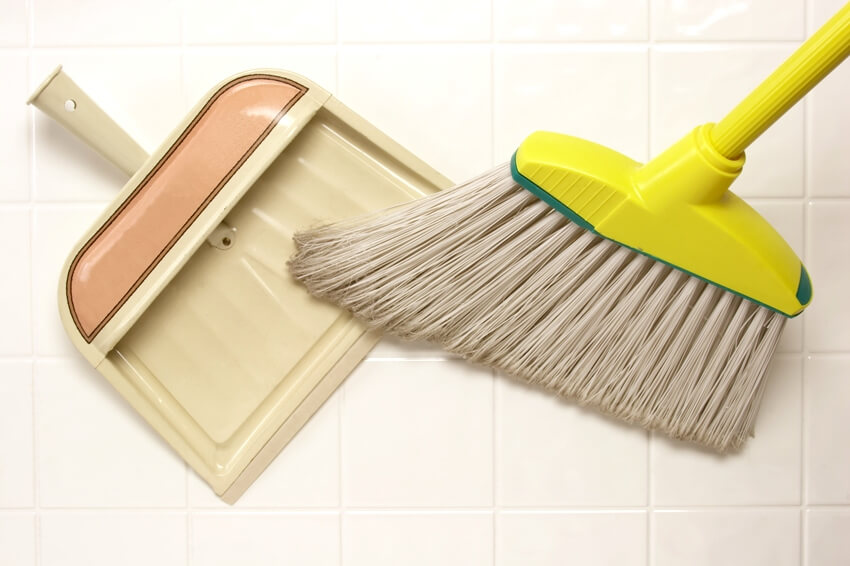
The angle broom is a highly modern broom that is widely known in many houses due to the efficient angle of the bristles. Rather than straight bristles, these brooms have them formed at an angle, making it simpler to clean in edges and at the kitchen toe kick.
Unlike standard brooms, which occasionally leave particles of food and dirt in these spots, angle brooms make it extremely simple to sweep just about anything. These brooms include plastic bristles that are designed to endure a long period without breaking out or falling apart.
The bristles of the broom will grow more flexible as it matures, making it simpler to get the broom head into small spaces with hardly any effort.
Rubber Broom

Rubber brooms are becoming more popular since their bristles can endure a category 5 hurricane. They are practically impossible to pull out, and their durability makes them ideal for cleaning floors and removing debris, particularly in comparison to other brooms.
Nevertheless, when it pertains to dust pickup, these brooms fall short. Rubber brooms might not be appropriate for sweeping a very dusty area, such as a hearth or entryway. They work well with dust particles and hair, though, particularly in areas with fans that blast pet dander and hair around.
Water Broom

Water brooms are a newfangled member of the cleaning realm as their mechanism is somewhat complex. A water broom is a cleaning instrument that washes surfaces by directing high-pressure water jets from nozzles in sharp directions. They have a long, tubular brush that rotates continuously to remove debris and filth.
These brooms are used alongside the water in locations like kitchens (particularly dirty kitchens), restaurants (when not in operation), garages, and wherever the flooring requires a wet sweeping rather than a dry one.
Water brooms are excellent for cleaning exterior surfaces, patios, and garages. Although they are used indoors, particularly in indoor areas where dirty floors are constant, they are also recommended to be used outdoors. These water brooms are highly suitable for outdoor commercial settings.
Broom Vacuum
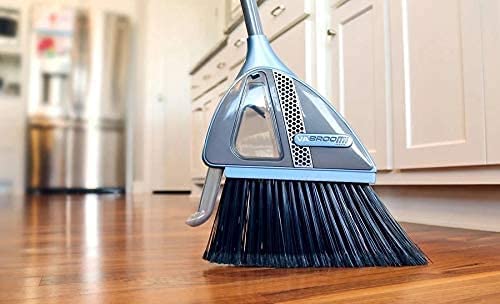
A broom vacuum is basically an advanced version of a standard sweep that combines its efficiency with the modern technology of a vacuum.
This type effectively removes dust, hair, and other debris without the use of wires, dustpans, as well as bending over. To have the debris disappear, you can carefully sweep it in a specific direction and press the nozzle onto the ground.
This modern broom is a cordless cleaning tool that sweeps and vacuums in a single action. To power up the vacuum, simply sweep dirt, hair, and debris into a mound and press the nozzle.
A quick release button allows you to discharge the trash receptacle. This is ideal for hotels and condominiums and is recommended for all hard flooring surfaces.
Whisk Broom
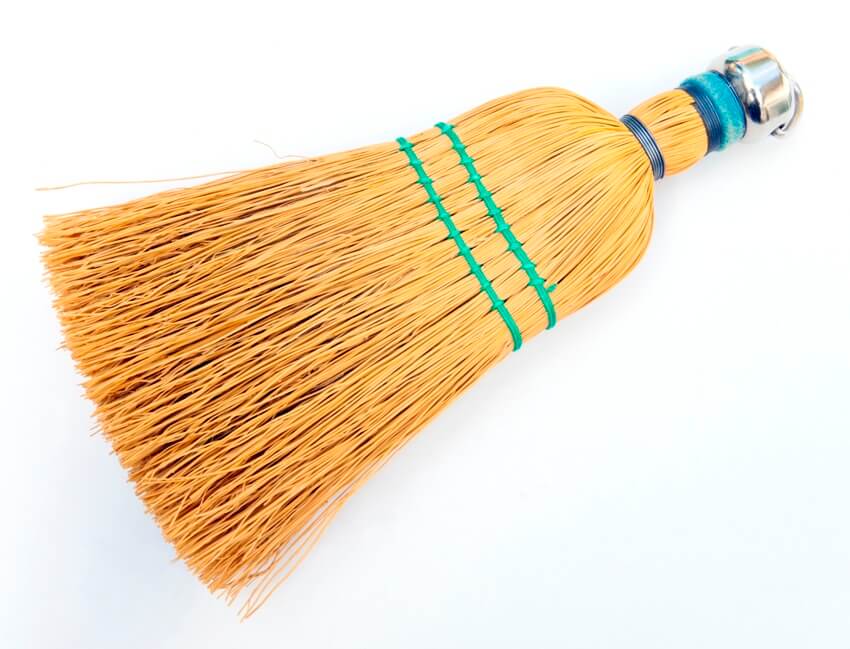
Although whisk brooms are often smaller than their bigger counterparts and appear to be comparable to hand brooms, the key distinction would be in the bristles. Because they contain natural fibers, the style has a more organic appearance that resonates with a wide range of individuals.
Furthermore, whisk brooms are ideal for minimal cleaning chores like picking up crumbs of spilled food in the kitchen or sweeping the keyboard on your desktop as the firm natural bristles can effortlessly slip in between the keys and ensure that nothing is left or pressed down into your keyboard.
Sad to say, whisk brooms do not normally come with a dedicated dustpan, so you must purchase one separately.
Hand Broom
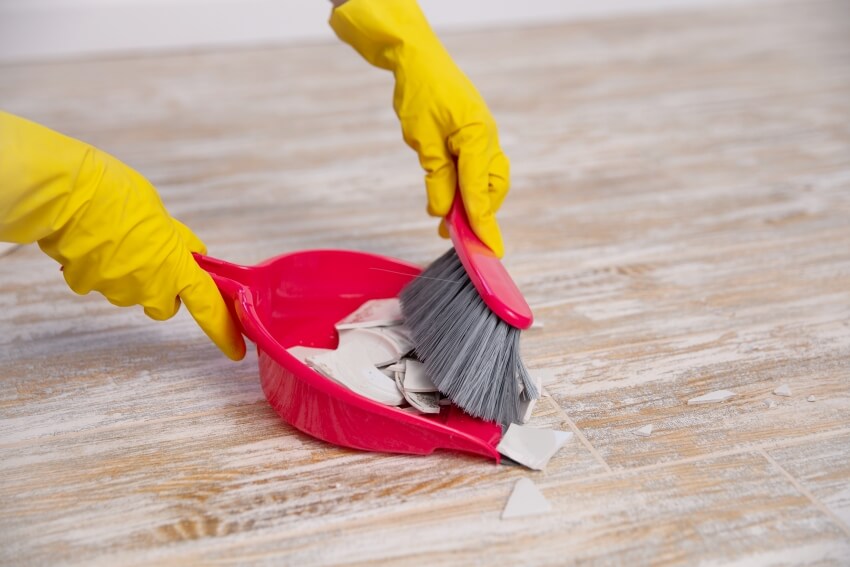
Most brooms feature a long handle that renders them easier to operate while standing vertically, but hand brooms feature a short handle. They are not suitable for cleaning huge areas but are beneficial for cleaning a small space on the spot.
By using a hand broom, you can guarantee that the work will be completed fast whenever there is a minor spillage and a small amount of debris that must be cleaned up promptly.
Hand brooms typically come with a dustpan that snaps onto the handle, making it extremely simple to dispose of debris without bothering to search your house for a separate dustpan.
These brooms are great for unexpected cleanups and keeping around the house to wipe up particles of dirt and debris that are tracked in. The bristles that are used on these brooms are often made of plastic.
Squeegee Broom
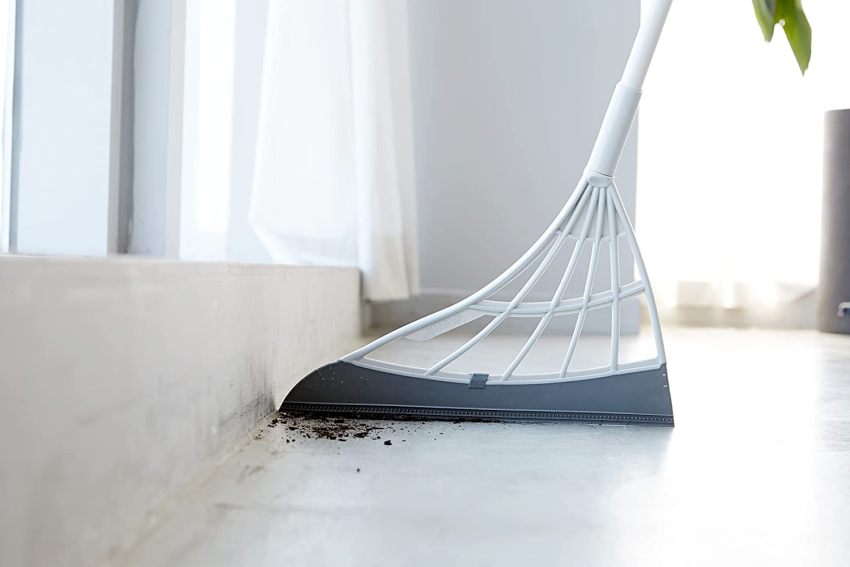
A squeegee broom includes a squeegee on one side to gather spills in one spot, whereas the rubber-made bristles on the opposite side reach deeply into the spill for rapid cleaning. This innovative type gives emergency personnel a broom that can accomplish just about anything.
These brooms are three times more durable than bristled styles. These types are washable and can be used repeatedly.
With movable knuckle joints, this broom is also ideal for cleaning under furnishings and gathering dust and hair. Once more, the gentle bristles will help you clean without damaging the flooring, whereas the squeegee side will shine them. Some models are manufactured of silicone, hence you will not have to fret about their longevity.
Expandable Broom
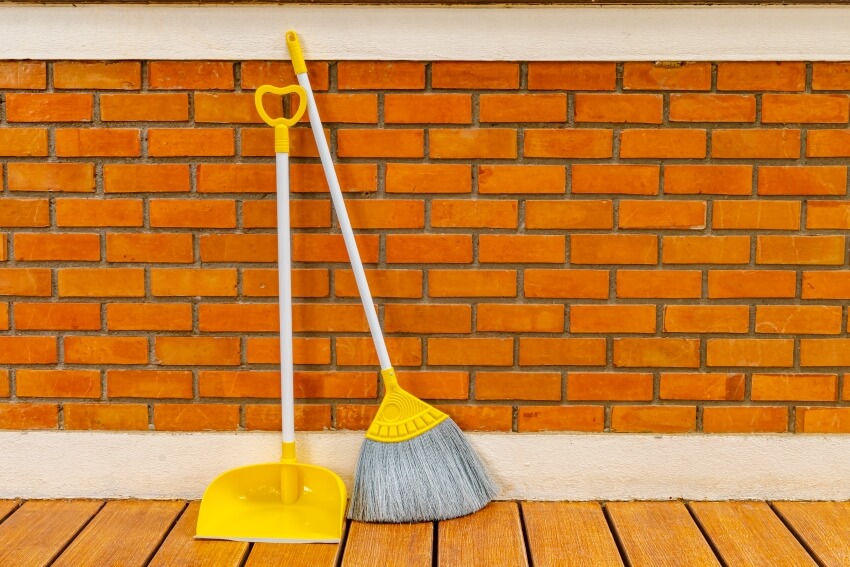
You may not have enough space to keep a full-size broom inside your house or business, but you, nonetheless, still need functional types in the event of spills.
Whenever you are in this scenario, an expandable broom would be your safest choice. This is fundamentally a broom with an extendable handle.
The expandable handle allows it to be adjusted to the right length for each individual before shrinking down to a much more practical size for storage.
Claw Broom
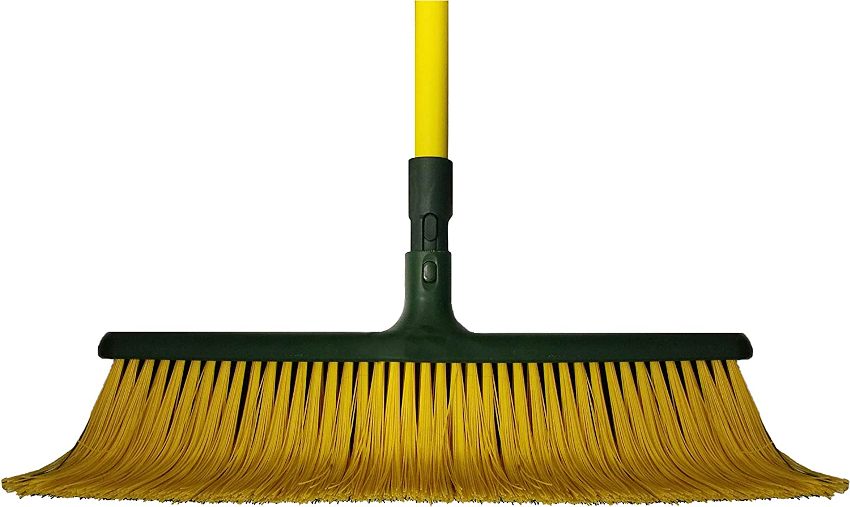
It may not be uncommon to find oneself shifting from a rake to a broom when doing landscaping tasks. You sweep the parking space and walk with it, then use the rake to clean rubbish from the yard. It is kind of a hassle. The claw style, on the other hand, solves this problem.
A claw broom combines the features of a rake as well as a standard sweep into one, enabling you to handle most landscaping work using a single instrument, sweeping and collecting every dirt and trash in sight with great enthusiasm.
A claw broom can handle various outdoor cleaning duties by itself, from gardens and pavements to pathways and patios, enabling you to complete basic yard work with one piece of equipment.
Furthermore, a claw broom replaces the standard style head with rigid, curving bristles that are comparable to the design of bow rake heads.
Due to the design, you can choose between push or pull motions to remove dirt, twigs, as well as debris, and the strong bristles enable it to function on both grasslands and pavements, even when wet.
Carpet Broom

A carpet broom is a piece of mechanical cleaning equipment that is used to clean carpets. They became popular before the development of vacuum cleaners and have been mostly overtaken by them.
Carpet brooms, on the other hand, continue to be widely used in various household and business applications as they are lightweight and silent, allowing users to swiftly clean up minor messes on the floor without bothering guests, patients, newborns, or pets, and they do not necessitate power to function.
Moreover, a carpet sweep is often made up of a little box. The box’s foundation is made up of wheels as well as brushes that are connected by a belt, gearbox, or sliders.
A dirt receptacle is also provided. When dragged along a carpet, the rollers or wheels spin, forcing the brushes to move. The brushes collect dust and dirt from the carpet and sweep them into the container.
Carpet brooms are typically height-adjustable, allowing them to work on varied lengths of carpet or plain floors. This style often has a long handle that allows it to be handled without leaning over.
Pet Hair Broom

A pet hair broom, as the name implies, is particularly intended to trap your pet’s fur. Pet dander is attracted to and trapped by these brooms, clustering it together for easy cleaning.
A pet hair sweeper works a lot similar to a magnet that collects pet hair from rugs, carpets, wooden floorboards, and even linoleum. It was created specifically as a carpet rake for collecting dog and cat hair. It can also be used to clean tiles, windows, and other surfaces.
This pet hair broom thoroughly cleans practically any flat surface. Check out our best floors for dogs guide for more helpful tips.
Concrete Broom
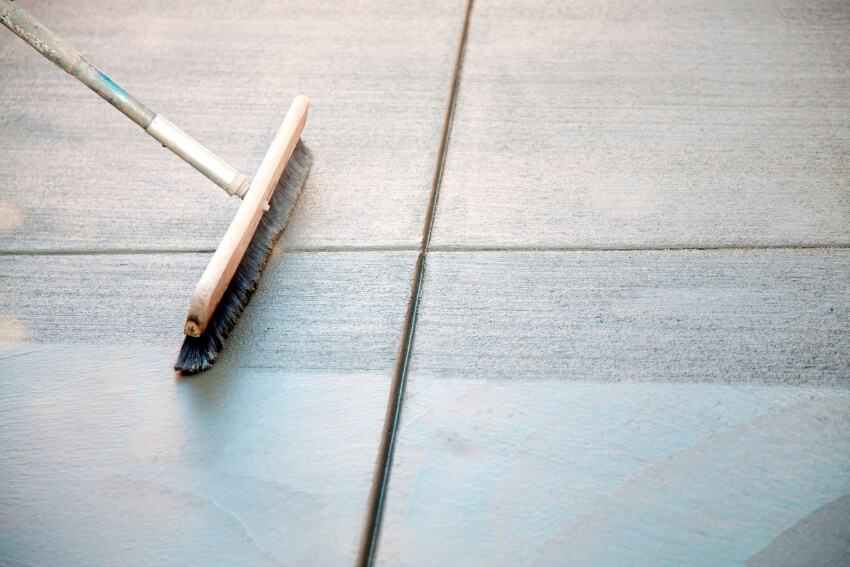
Concrete brooms are not meant for cleaning purposes. They are, however, used to give finished concrete a fine texture. This might be done for aesthetic reasons or to produce a more reliable non-skid ground.
The bristles of a concrete broom are typically softer than those on standard cleaning styles. When using this type, you do not want it to create too much or inconsistent texture on the concrete surface.
Scrub Broom
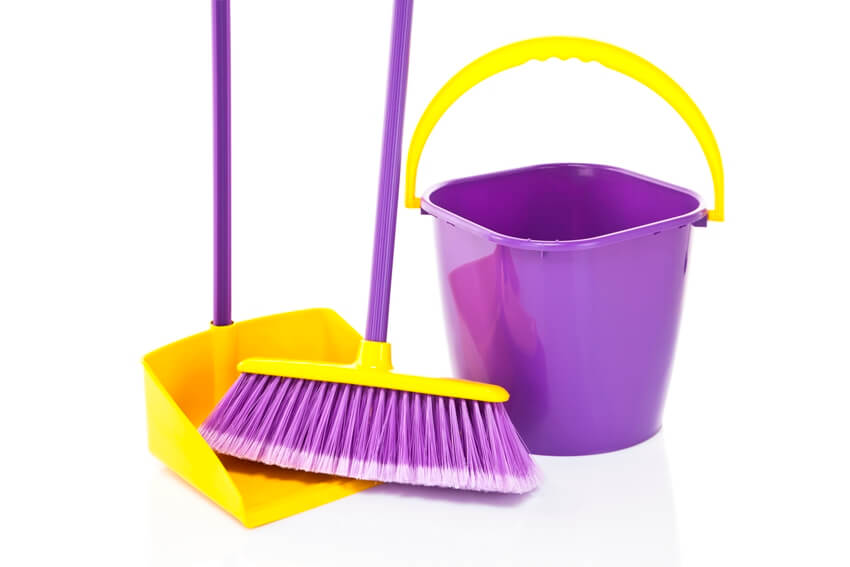
A scrub broom is a small-sized cleaner that is meant to clean small objects in your kitchen, bedroom, living room, etc. It consists primarily of short bristles designed for scouring filthy objects.
This type of broom usually has a protruding grip that prevents your hands from contacting unclean surfaces and chemicals, allowing you to apply more pressure and achieve a deeper cleanup. It is also useful for cleaning the interiors of machinery with narrow access points.
Decorative Broom (Besom)
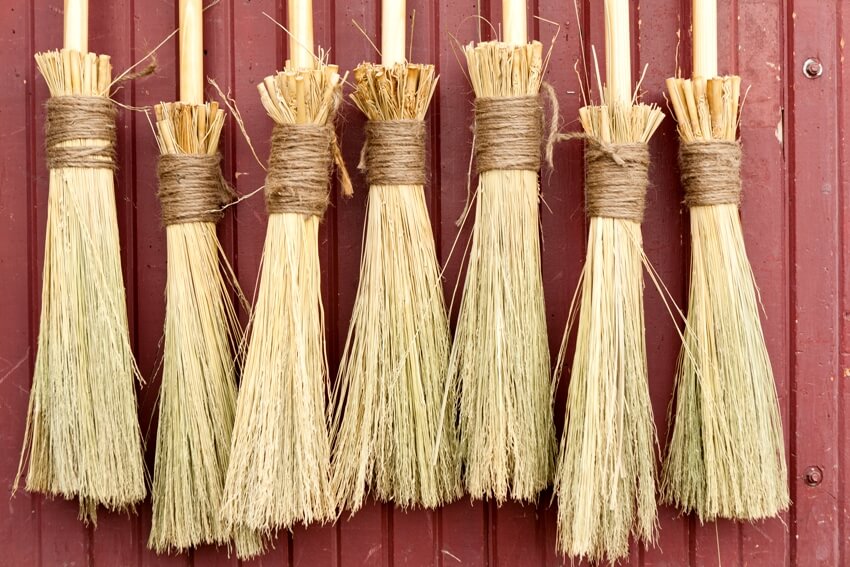
Decorative or besom brooms are made of twigs firmly wrapped around a wooden stick. They are not as durable as modern, softer brooms, and the hardness of the twigs restricts how much cleaning they can do before separating and breaking.
As a result, an increasing number of people who adore besom brooms merely utilize them as decorative items in their homes rather than as functional brooms. They are frequently used to depict brooms used by witches to glide, therefore they make ideal Halloween embellishments.
Soft Brooms Vs Hard Brooms
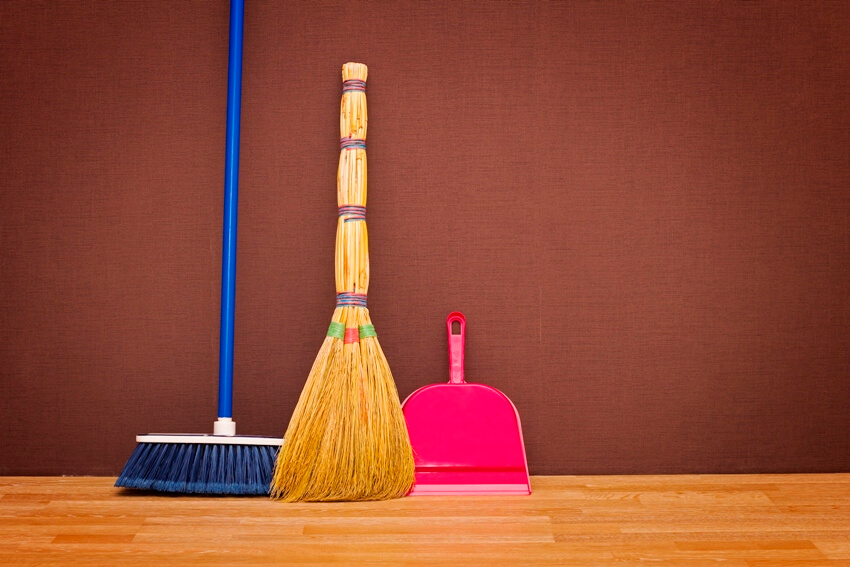
Soft brooms have bristles composed of a variety of materials, and the one you will select is entirely up to your needs and preferences. The bristles on all of them have the same fan form.
Even though they are referred to as “soft brooms,” the bristles are robust enough to withstand continuous sweeping and handling and do not flex as much as grass-based brooms. Soft brooms that are composed of corn husks are widespread since they provide the ideal level of strength for basic sweeping.
Although certain individuals initially find them a bit challenging to use, soft brooms will undoubtedly endure for many years. This is due to the bristles’ strength and ability to retain their shape.
Nevertheless, after continuous usage, the bristles will flex and move further with the action of the broom, making it simpler to handle and get into narrower spots. These brooms normally have multiple rows of tight stitching at the upper end of the bristles to keep them in position and preclude them from wiggling.
A hard broom, on the other hand, could be the best solution if you need a product with firmer bristles compared to a soft style. They feature much firmer bristles, making them ideal for penetrating into holes and crevices and clearing out the filth that is within.
Soft brooms are unable to clean up these spaces, but hard styles have sufficient strength. They are also an excellent type to use if the area to be cleaned, such as a hearth, is too filthy to vacuum but still has to be cleaned.
Broom Brush Fibers
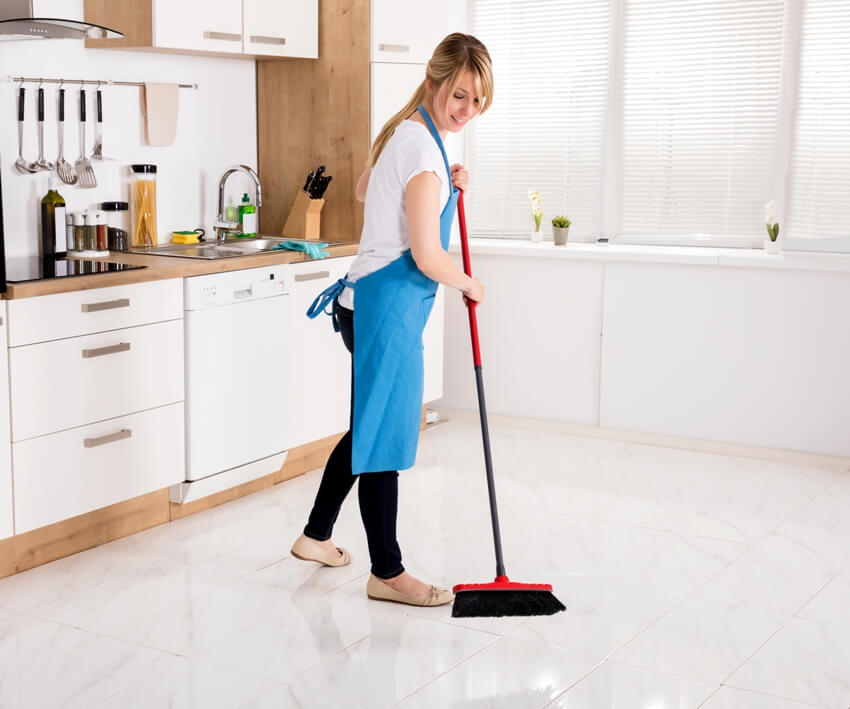
Here are the most popular broom fibers to choose from and when you would use them.
Plastic
Plastic bristles are available in many different kinds, but brush fibers that are made of polypropylene and poly are the most common today. They are employed in nearly every broom and brush solution. Synthetic bristles can be used for both wet and dry clean-up jobs.
Polypropylene is less expensive than nylon and is fungi-resistant. Polypropylene brush fibers work well for medium to heavy-duty floor sweeping and scrubbing. Moreover, these brush fibers are abrasion-resistant and offer great durability.
This broom brush fiber is able to withstand water, solvents, acids, oils, fungi, and bacteria development and will not discolor, degrade, absorb odors, or turn yellow. Furthermore, it is suitable for both wet and dry applications, as well as indoor and outdoor usage.
These fibers are delicate and usually have split tips, allowing them to perform superbly with precise sweeping. They are not quite as rough as other synthetic fibers used to make bristles. Because of the polypropylene fiber construction, these brooms are great for smooth interior surfaces and guarantee that no object that might cause a trip or fall danger will be left behind.
Poly, on the other hand, is a much more durable fiber for bristles and works well on rougher surfaces such as an exterior pathway, garage, cellar, or patio. Most elements that must be swept away can be handled by a blend of soft and stiff fibers.
This broom, which has soft fibers on the exterior and stiff fibers on the interior, can collect heavier things such as piles of dirt and leaves, along with sawdust and other dust particles.

Since synthetic bristles are very resistant to acids and grease, they can be utilized on dry or wet surfaces. Synthetic bristles are extremely flexible and will not harm your floor’s surface.
They are strong but pliable, making them ideal for routine cleaning of minimal waste on smooth floors such as laminate or hardwood. Brooms with synthetic fibers are typically used indoors. They are usually water-resistant and do not absorb odors.
Bassine Fibers
Bassine bristles are manufactured from palm leaves and are naturally occurring brush fiber. These stiff fibers are ideal for cleaning and sweeping surfaces like tiles, hardwood floors, and virtually any dry surface. They should not, however, be used on wet surfaces since they may deform.
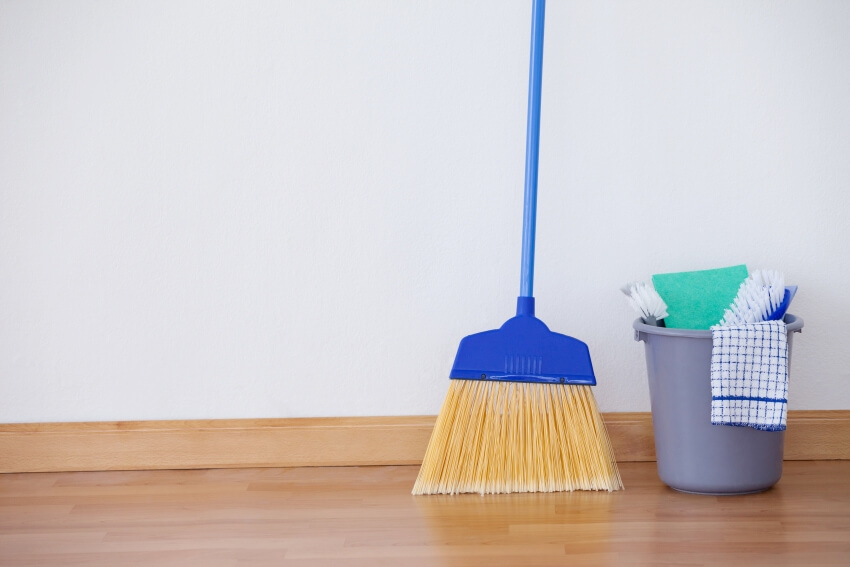
Flagged bristles have fractured and spiky ends. This converts a single bristle into a slew of bristles. Fine particles are best swept using these bristles. A flagged brush with broken ends is ideal for sweeping finer powders like flour in a baking area.
Furthermore, flagged bristles are useful for sweeping crumbs, sand, and other light debris in dry locations. Moreover, they work effectively on smooth floors with no irregularities like concrete or hardwood that has no grouting or uneven surfaces.
Metal Bristles
The metal that is often used in these bristles is often a medium- to high-carbon material that is extremely strong and springy. Depending on the application, other brushes or brooms have fibers composed of brass or stainless steel.
A metal brush fiber is essentially an abrasive tool used for removing rust and stripping paint. It is also used to scrub surfaces and provide greater conductive space for establishing electrical connections, including those found between car battery terminals and their connectors, where filth and dirt have accumulated.
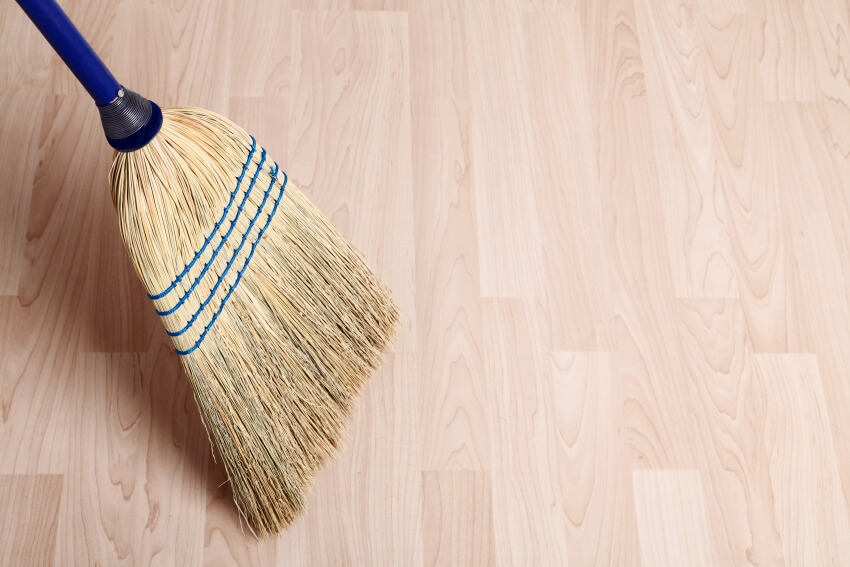
For broom brush bristles, corn fiber is a widely popular material. Although it is quite durable, it is not so rigid and hard that it will not bend when using it.
Trace amounts of dirt and debris can be swiftly swept out from beneath tables, chairs, sofas, and appliances thanks to the straight fibers’ ability to capture them. Corn-fiber brooms are a wonderful option for most households because they are generally affordable and accessible.
Palm Fiber
Palm fiber, which is incredibly robust, has long been used to make brooms that are strong enough to handle rigorous sweeping. Because palm fibers are so durable, they can withstand heavy loads and harsh debris without being ruined.
Additionally, palm fibers can easily sweep rubber, pebbles, big sections of dirt, and twigs, whereas softer bristles would struggle to do so. They work well for clearing a worksite or removing washed-out gravel and rock from a pathway, but they are not the best for fine cleanup within a home or office.

In dry settings, grass fiber bristles are great for sweeping dust and fine debris. Such bristles are professionally bonded and fashioned grass fibers, making them extremely resilient while remaining non-damaging to your flooring. However, they are not suitable for wet surfaces.
Horse Hair
Horse hair brooms are often used for very soft flooring to prevent scratches. They can also be used effectively to capture cobwebs or clean up dusty areas.
Horse hair is frequently used in combination with another bristle material because it is exceedingly soft by itself. It performs effectively with other materials as it is soft and light enough to handle microscopic bits of dust, dirt, and debris.
This implies that the extra material in a product with horse hair can accommodate larger amounts of filth and objects that must be swept, and the horse hair follows behind it to complete the cleaning work, producing an extremely clean and tidy floor.
What Size Are Broom Handles?
The length of the handles of brooms varies from 4 to 9 feet. Every one has specific uses, hence the size of the handles will vary greatly amongst brooms. As previously stated, certain brooms have extendable handles.
What Are The Parts Of A Broom Called?

The vast majority of brooms are made up of four major parts. Different varieties may have distinct pieces, but these four parts are quite common.
• Shaft. The shaft is the pole that spans the length of the item. It serves as the sweeping handle provided for the user.
• Brush. The bristles or fibers make up the brush, which is bonded firmly by the cap.
• Hook. The hook is located at the very top of the broom’s shaft. It allows it to be stored in a storeroom.
• Brush Cap. The brush cap is both decorative and functional. It keeps the bristles in place and gives it a nice look.
How To Clean A Broom
Brooms normally gather dirt, grit, and filth owing to the manner in which they are used. Frequent cleanings are henceforth necessary to prevent the spreading of uncleanliness and to keep your brooms clean. Furthermore, if the bristles are consistently maintained, it will clean your house or workplace more efficiently and thoroughly.
Here are some basic steps on how you can clean your broom:
• Remove any remaining debris. Dust, dirt, and occasionally hair can adhere to the bristles. Before you start using it, you should eliminate any debris with your hands or a vacuum cleaner.
• Soak the bristles of your broom with soapy water. Washing the bristles keeps them clean and prevents the risk of cross-contamination. However, doing this step may not apply to certain types of bristles such as corn, grass, and bassine fibers. You can, on a positive note, follow this step on brooms with plastic, synthetic, palm fibers, and horse hair.
• Make use of a disinfecting spray. Use a disinfectant spray to clean your handle as well as your dustpan.
Tip: Use a different broom for each distinct sweeping task. This aids in preventing germs from spreading to other locations.
Best Broom For Hardwood Floors

The best hardwood floor broom must have gentle bristles that will not hurt delicate surfaces yet can thoroughly pick up dirt particles, debris, and pet dander.
They should also keep dust out of the air, leaving only the luster and natural radiance of the hardwood. Hence, upright brooms with plastic fibers (particularly poly) would be ideal to be constantly used on hardwood floors.
The O-Cedar 3-Action Upright Broom could be great for sweeping your hardwood flooring. It features innovative bristle technology for better cleaning efficiency on wooden floors. No doubt, your hardwood floors will remain spotless and will not get scratched because of the gentle bristles.
Best Broom For Dog Hair

A dedicated dog hair broom is essential as it is designed to clear all the dirt and fur without leaving any particles behind. It also reduces the amount of effort and exertion required to remove hair from the floor. The best dog hair sweep will not only help you remove hair but will also keep the floor clean.
Rubber brooms are normally recommended for removing dog hair. Thus, if you are looking for a high-quality product, you can consider using the FURemover. This pet hair sweep is made entirely of natural rubber and functions as a pet hair magnet, effortlessly trapping fur from rugs, carpets, and even hardwood floors.
Visit our guide to laundry room essentials for more cleaning supplies ideas.






